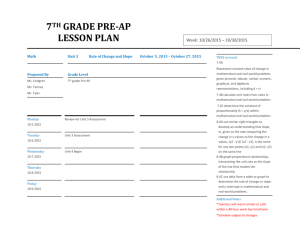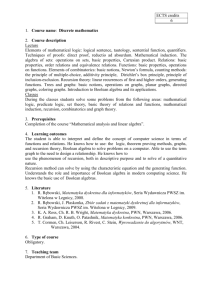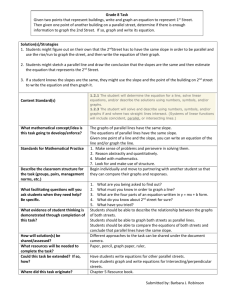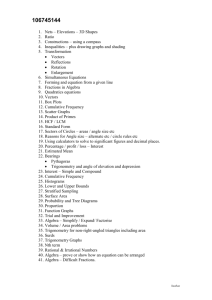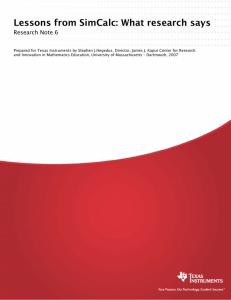Kaput, James
advertisement
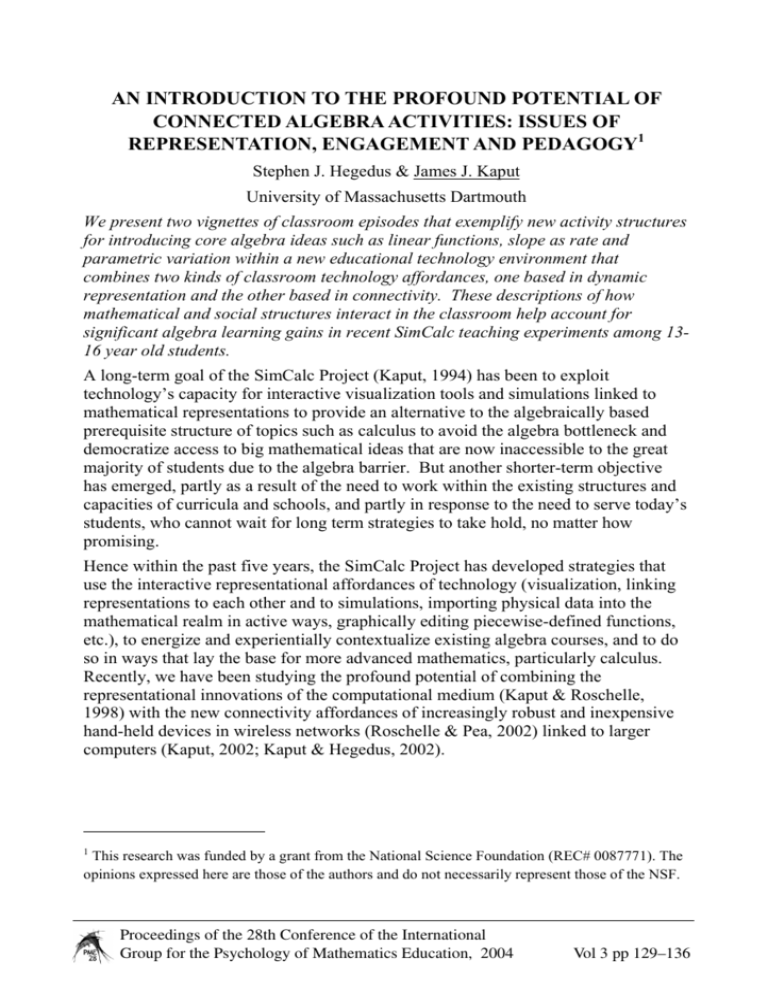
AN INTRODUCTION TO THE PROFOUND POTENTIAL OF
CONNECTED ALGEBRA ACTIVITIES: ISSUES OF
REPRESENTATION, ENGAGEMENT AND PEDAGOGY1
Stephen J. Hegedus & James J. Kaput
University of Massachusetts Dartmouth
We present two vignettes of classroom episodes that exemplify new activity structures
for introducing core algebra ideas such as linear functions, slope as rate and
parametric variation within a new educational technology environment that
combines two kinds of classroom technology affordances, one based in dynamic
representation and the other based in connectivity. These descriptions of how
mathematical and social structures interact in the classroom help account for
significant algebra learning gains in recent SimCalc teaching experiments among 1316 year old students.
A long-term goal of the SimCalc Project (Kaput, 1994) has been to exploit
technology’s capacity for interactive visualization tools and simulations linked to
mathematical representations to provide an alternative to the algebraically based
prerequisite structure of topics such as calculus to avoid the algebra bottleneck and
democratize access to big mathematical ideas that are now inaccessible to the great
majority of students due to the algebra barrier. But another shorter-term objective
has emerged, partly as a result of the need to work within the existing structures and
capacities of curricula and schools, and partly in response to the need to serve today’s
students, who cannot wait for long term strategies to take hold, no matter how
promising.
Hence within the past five years, the SimCalc Project has developed strategies that
use the interactive representational affordances of technology (visualization, linking
representations to each other and to simulations, importing physical data into the
mathematical realm in active ways, graphically editing piecewise-defined functions,
etc.), to energize and experientially contextualize existing algebra courses, and to do
so in ways that lay the base for more advanced mathematics, particularly calculus.
Recently, we have been studying the profound potential of combining the
representational innovations of the computational medium (Kaput & Roschelle,
1998) with the new connectivity affordances of increasingly robust and inexpensive
hand-held devices in wireless networks (Roschelle & Pea, 2002) linked to larger
computers (Kaput, 2002; Kaput & Hegedus, 2002).
1
This research was funded by a grant from the National Science Foundation (REC# 0087771). The
opinions expressed here are those of the authors and do not necessarily represent those of the NSF.
1
Proceedings of the 28th Conference of the International
Group for the Psychology of Mathematics Education, 2004
Vol 3 pp 129–136
EMERGING THEORETICAL COMMITMENTS
We have come to see classroom connectivity (CC) as a critical means to unleash the
long-unrealized potential of computational media in education, because its potential
impacts are direct and at the communicative heart of everyday classroom instruction
– more so than internet connectivity. We are now beginning to build insight into how
those new ingredients, in combination, may provide the concrete means by which that
potential may be realized, because they may, in fact, help constitute the first truly
educational technologies, intimately situated within the fundamental acts of active
teaching and active learning. This embeddedness may indeed be more profound than
we initially recognized, because these ingredients resonate deeply with broader views
of learning as participation (Lave & Wenger, 1991) and no longer fit within a
“learning in relation to a machine” (large or small, in the lab, classroom or even your
hand) view of educational technology. Indeed, the paradigm is shifting towards one
where the technology serves not primarily as a cognitive interaction medium for
individuals, but rather as a much more pervasive medium in which teaching and
learning are instantiated in the social space of the classroom (Cobb, 1994). We
deliberately choose “instantiated” ahead of “situated” (Kirshner & Whitson, 1997)
because we have repeatedly seen mathematical experience emerge from the
distributed interactions enabled by the mobility and shareability of representations.
The student experience of “being mathematical” becomes a joint experience, shared
in the social space of the classroom in new ways as student constructions are
aggregated in common representations – in ways reminiscent of, but distinct from
those of a participatory simulation (Stroup, 2003; Wilensky & Stroup, 1999). This
epistemological shift in the place of technology in classrooms is fundamental to our
theoretical perspective.
CONTEXTUALIZATION OF VIGNETTES IN PRIOR SUCCESS STORIES
The empirical work behind this report investigated the impact of our constellation of
technological, curricular and pedagogical innovations on student learning, especially
as measured by independent standard test items on a pre/post-test basis. They include
intense teaching experiments aimed at core algebra topics in middle and high-school
classrooms in both Massachusetts and California. Results demonstrate comparably
positive outcomes under substantially different instructional and technological
conditions, somewhat different curricular targets, and different student demographics
(Tatar, et al, in submission).
Pre/post-test measures (see http://www.simcalc.umassd.edu/) triangulated with
observational video and field-note data in these and other instructional situations in
undergraduate classrooms provide evidence of significant improvements in students’
algebraic thinking as measured by students’ performance. For example, in our afterschool intervention (n=25), students performance was significantly better on post
tests (p<0.001), with high effect sizes (Cohen’s d=1.80sd) and strong gains occurring
across disjoint populations (middle and high school) with relative statistical
independence of prior knowledge, based on Hake’s gain statistic (Hake, 1998) –
3–130
2
PME28 – 2004
(<Post> – <Pre>)/(1 – <Pre>), reflecting strong impact of the intervention itself as
exploiting very different kinds of prior knowledge in the two subpopulations (see
Hegedus & Kaput, 2003; under review, for further details).
PARTICIPATORY AGGREGATION OF STUDENT CONSTRUCTIONS TO
A COMMON PUBLIC DISPLAY
In a connected algebra environment the class is typically subdivided into numbered
groups, where the size and number of groups fit both the given size of the class and
the mathematical activity (ranging from the whole class to pairs). Groups are often,
although not necessarily, defined “geographically” – students who are physically near
each other. The students usually also “count-off” inside the group, so that each
student then has a two-number identity that can then serve as "personal parameters,"
a Group Number and a Count-Off Number. Students then create mathematical
objects – in the cases discussed here, linear Position vs. Time functions that drive
animated screen objects. The functions depend in some critical way on students’
respective personal parameters either on a hand-held device or on a computer.
SimCalc MathWorlds runs on the TI-83Plus as a Flash Application (Calculator
MathWorlds - CMW), and on desktop computers as a Java Application (Java
MathWorlds - JMW). When using CMW or JMW (the scenario for this report),
students’ constructions are uploaded to the teacher where they are aggregated,
organized and selectively displayed using JMW and discussed.
Staggered Start, Staggered Finish (Y=mX+b): The simplest case is to produce
families of functions defined by a single parameter, such as the “b” in Y=2X+b,
where b varies according to, say, Group Number. Then each student in a group
produces the same position function (Y=2X+ Group Number) on his/her own device,
so a given group’s linear graphs all overlap (same Y-intercept and same slope = 2),
and the different groups’ graphs are parallel. When animated, the screen objects
“representing” the members of a given group move alongside each other "as a
group," while the different groups move at the same velocity but are offset by their
initial positions (see Link 1 at http://www.simcalc.umassd.edu/PME04.htm). Here,
the group provides mutual support, and it is of special interest that the superposition
of graphs provides a strong visual realization of function equality.
By clicking on the overlapping graphs, we can bring different graphs of a group to
the front. Further, the graphs and their corresponding objects (“Dots” in “Dots
World”) are color-coordinated, so the sequence of graph-colors that appear matches
the sequence of colors of the objects of the given group. In addition, with the View
Matrix (see Link 2 at http://www.simcalc.umassd.edu/PME04.htm), the teacher has
virtually full control of which graphs and objects are displayed, and how they are
organized or colored – e.g., by Group Number or by Count-Off Number.
With this simple example in mind, we present two vignettes that correspond to some
of the learning gains demonstrated in our interventions.
PME28 – 2004
3
3–131
Vignette 1: Varying M systematically – Slope as Rate both positive and negative
The Staggered Start – Simultaneous
Finish activity is more complex
than the former and requires the
students to start at 3 times their
Count-Off number but “end the
race in a tie” with the object
controlled by the target function
Y=2X (so the target racer moved at
2 feet per second for 6 seconds and
started at zero – see the bottom
graph in Figure 1). Students now
need to calculate how fast they
have to go to end the race in a tie.
And since they start at different
positions, the slope of their graphs
changes depending on where they
start, which in turn depends on their
personal Count-Off Number. Each
group is limited to 5 people and
Figure 1: Simultaneous Finish
while the group number does not
affect their constructions it gives rise to a smaller, more manageable set of functions
to discuss (see Link 3 at http://www.simcalc.umassd.edu/PME04.htm). Secondly,
and more importantly, the Count-Off Numbers 4 and 5 give rise to two important
slopes. The person with Count-Off Number 4 has a graph with constant slope,
Y=0X+12, since he starts at 12 ft, which is the finish line, so he does not have to
move! The person with Count-Off Number 5, starts beyond the finish line (15 ft) and
so has to run backwards, thus forcing the student to calculate a negative slope. We
have observed students in a variety of settings using various strategies including:
numerical trial-and-error, inputting values into an X-coefficient field in the algebra
window (a feature of the software for algebraic editing), slope-based analysis (“What
slope to I need to connect my starting position to (6, 12)?”), velocity-based analysis
(“How fast do I need to move get to 12 at 6 seconds?”) and, by an implicit
parametric-variation strategy, comparing what others had done in their group and
averaging (i.e., observing that the slope of each person’s graph changed by 0.5 as the
Count-Off Number increases by 1).
Organizing and displaying student work is a strategic pedagogical decision, e.g., in
focusing student attention on the underlying mathematical structure. An important
question to ask before animating the motions for the whole class is “What will the
race look like?”
The aggregate motion in the classroom display becomes a personal reality through
the personal link with Count-Off Number. By aggregating and displaying the class
3–132
4
PME28 – 2004
work, students can observe how their personal construction fits into the “race” and
allows them to note how people from other groups had constructed identical motions
because of their Count-Off Number. In addition the shape of the graph and the parity
of the slope for those who had to start past the finishing line (i.e. run backwards) was
made more realistic and understandable in this motion-based scenario. In discussing
different strategies and making these explicit in publicly examining outliers (incorrect
answers) and natural outliers (motions for students with Count-Off Numbers 4 and 5)
we have some evidence to why students began to improve on items of the pre-post
test which involved slope analysis.
Vignette 2: Using both Group Number and Count-Off Number – creating “fans”
to address the idea of slope-as-velocity
In this vignette we discuss an activity structure where we systematically increase the
complexity of the variation by using the other part of the unique identifier – the group
number. Students now have to create functions so that their object will travel at a
velocity equal to their Count-Off Number but start at their Group Number. We
highlight here the move from a personal individual construction to a significant group
structure to a class aggregation. Each group creates a family of functions, which is
similar in shape (“a fan”) to every other group but offset by starting position.
Students anticipate the visual form of the aggregation as is highlighted in the
transcript, where the class was asked what the collection of graphs would look like.
J
It’s gonna start at two, and it’s gonna end at five, and… it’s gonna look
kinda like a fan. And, they’re all going to start at the same place. <SNIP>
T
So, he’s saying they’re gonna start there, and then it’s gonna kinda look
like a fan?
J
Yeah they’re gonna… {spreads out fingers wide on one hand} like that.
T
… You like that? {hands up for more than half the class}
{Clapping and a few ‘yeahs’, as the results are displayed}
Here, John (J), indicates to the class physically with his hands (where his fingers
resemble individual graphs) that the aggregation will resemble “fans” how these
groups of functions will be displayed relative to each other. But although John knew
where his graph was in the aggregate, he could not explain why in technical, slope
terms. Here we highlight the social dynamic enabled by such a public event, which
allowed two other students Alison (A) and Robert (R) to explain why John’s graph
(with slope 3) is the one highlighted by linking its slope to the velocity.
A
Go by velocity… however many… what number in a group you’re in…
how many increments he goes.
T
Okay. So, he’s the third member of the group. So..
A
So he can go three times every second. Up three every second.
T
… How can we determine, Robert?
PME28 – 2004
5
3–133
R
See how far it goes… look between zero seconds and one second?
T
You want to come show us?
R
Okay. {Robert goes to the display and inscribes the first one-second
segment of the graph with a 1-wide by 3-tall rectangle}
We observed a high level of engagement by the class and reaction to the animation of
the aggregate, which resulted in a wide distribution of the actors by the end of the
animation. This was an opportunity to highlight how some people finished at the
same place and time but followed different motions, without delving into the
algebraic detail of why this occurred. This activity intends to provide an experience
embodying parametric variation across both the graphical representation (see figure
2) and the motion-based gestalt of the animated objects – just as the collection of
graphs has a gestalt-shape captured in the fan metaphor, the collective motion has a
gestalt (see (see Link 4 at http://www.simcalc.umassd.edu/PME04.htm) for a sense of
it.
We also highlighted and examined
outliers, making a conscious
decision in this case not to hide the
names (or identifiers) of the
students, although we note the issue
of student anonymity in class
(Scott, 1999). The software includes
the ability for the teacher to hide
names of selected functions if
desired (identifying information
appears in the lower left hand
corner of the screen). Nevertheless,
the class often took the initiative to
determine who the outlier was, what
the underlying error was, and then
collectively correcting the mistake.
In effect, the mathematical criteria
Figure 2: Making “fans” from two groups
of consistency comes to be socially
embodied in class norms of “correctness” and coherence.
At this stage, differences in students’ work are based on inter-group variation (similar
fans but off-set) and intra-group variation (the establishment of one fan where
individual Count-Off Number varies slope). To further build meaning of how
variation in their identifiers leads to variation in their corresponding graphs, we
reversed the roles of Group Number and Count-Off Number: We asked students to
repeat the task but now construct a motion where they travel at a velocity equal to
your Group Number for 5 seconds, and start at your Count-Off Number. Here
students will produce a visually similar class aggregate, but their personal graph is
now part of a fan constructed by members of other groups. In fact, their own group
3–134
6
PME28 – 2004
now constructs families of parallel lines, and, of course, their motions differ
accordingly from the previous case.
CONCLUSION: ADDRESSING NEW PEDAGOGICAL DECISIONS
The connected SimCalc algebra classroom opens up a new learning environment for
students, with increased intensity, structures and levels of participation. In presenting
these brief vignettes outlining the student activity and decisions the teacher made
during the post-aggregation phase of the activity (space prevents descriptions of
within-group interactions), we have begun to describe how students begin to develop
an understanding of one of the core ideas of high school algebra, slope-as-rate-ofchange. Through such activities, students have both an individual “mathematical
responsibility” to either their group or to the larger class via construction or
interpretation of shared mathematical objects, as well as a vicarious participation in
the joint construction upon aggregation. With careful pedagogical decision-making
by the teacher students’ attention is now moved along a trajectory from static, inert
representations, to dynamic personally indexed constructions in the SimCalc
environment on their own device, to parametrically defined aggregations of
functions, organized and displayed for discussion in the public workspace.
Substantial teacher knowledge, a deep composite of content and pedagogy, is needed
to facilitate movement along this trajectory and focus public mathematical dialogue
on critical features of these visually shared objects to develop meaning. This is
hinted at in the last illustration, where Count-Off and Group Numbers are
interchanged. In effect, connectivity supports the pedagogical manipulation of
student’s focus of attention. But the teacher knowledge needed to take advantage of
a connected classroom requires extended development.
How do your An Individual vs. the Group
Motion(s)
Graphs
Look Different as
An Individual vs. the Class
Formula
Look the Same as
The Group vs. the Class
Tables
Table 1: Constructing pedagogical actions
Table 1 outlines a simple structure, which can guide the teacher’s inquiry. Choosing
one item from each column leads to a particular question that can be addressed to
individual students, groups or the whole class. Successively using this outline might
assist teachers in moving students along suitable learning trajectories in this
environment and elevating mathematical attention.
In our later activities in the interventions, aggregation was used as a means for
generalization and abstraction. As more work is conducted publicly, learning
increasingly occurs in the social space to complement the individual deviceinteraction space. Encouraging students to make sense of their constructions
PME28 – 2004
7
3–135
publicly, annotating their graphs on the display space, and systematically highlighting
parametric differences leads to more powerful understandings.
Having highlighted the benefits of social engagement in these activities, we also need
to investigate in more detail the potential for negative social implications in some of
these pedagogical actions and classroom decisions (e.g. issues of privacy, social
embarrassment). We are confident, however, that by combining the two key
ingredients, dynamic representations and connectivity technology, students can better
understand fundamental, core algebra ideas by forming new, personal identityrelationships with the mathematical objects that they construct individually and
collaboratively with their peers.
References
Cobb, P. (1994). Where is the mind? Constructivist and sociocultural perspectives on
mathematical development. Educational Researcher, 23(7), 13–20
Hake, R. R. (1998). Interactive-engagement vs. traditional methods: A six-thousand-student
survey of mechanics test data for introductory physics courses. American Journal of Physics,
66, 64–74.
Hegedus, S. J., & Kaput, J. (2003). The effect of SimCalc connected classrooms on students’
algebraic thinking. In N. A. Pateman, B. J. Dougherty & J. Zilliox (Eds.), Proceedings of the
27th Conference of the International Group for the Psychology of Mathematics Education (Vol.
3, pp. 47–54). Honolulu, Hawaii: College of Education, University of Hawaii.
Hegedus, S. J. & Kaput, J. (under review). Improving algebraic thinking through a connected
SimCalc MathWorlds classroom. Journal of Research in Mathematics Education.
Kaput, J. (1994). Democratizing access to Calculus: New routes using old routes. In A.
Schoenfeld (Ed.), Mathematical thinking and problem solving (pp. 77–156). Hillsdale, NJ:
Erlbaum.
Kaput, J. J., & Roschelle, J. (1998). The mathematics of change and variation from a millennial
perspective: New content, new context. In C. Hoyles, C. Morgan, & G. Woodhouse (Eds.),
Rethinking the mathematics curriculum (pp. 155–170). London: Springer-Verlag.
Kirshner, D., & Whitson, J. A. (1997). Situated cognition: Social, semiotic and psychological
perspectives. Mahwah, NJ: Erlbaum.
Lave, J., & Wenger, E. (1991). Situated learning: Legitimate peripheral participation. New York:
Cambridge University Press.
Roschelle, J., & Pea, R. (2002). A walk on the WILD side: How wireless handhelds may change
computer-supported collaborative learning. International Journal of Cognition and Technology,
1(1), 145–168.
Scott, C. R. (1999). The impact of physical and discursive anonymity on group members' multiple
identifications during computer-supported decision making. Western Journal of
Communication, 63(4), 456–487.
Stroup, W. (2003). Understanding qualitative calculus: A structural synthesis of learning research.
International Journal of Computers for Mathematical Learning.
Wilensky, U. & Stroup, W. (1999). Learning through participatory simulations: Network-based
design for systems learning in classrooms. Paper presented at the Computer Supported
Collaborative Learning (CSCL '99) Conference. December 12–15, 1999, Stanford University.
3–136
8
PME28 – 2004

